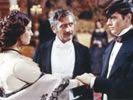Eye For Film >> Movies >> The Leopard (1963) Film Review

This beautiful and intelligent film is generally regarded as Visconti’s masterpiece. Set in Sicily in the 1860s, it is the time of the Risorgimento, when Italy, a loose collection of principalities, became a unified nation. Shot almost entirely on location, it brilliantly captures the final days of a society about to change forever through the personal story of one Sicilian prince, Don Fabrizio Salina (Burt Lancaster) and his family.
The film is based on the novel by Giuseppe Tomasi Di Lampedusa, who had grown up in an aristocratic society, his home bombed by Americans in the Second World War. Visconti, with his own aristocratic connections and Marxist leanings, was the perfect director to bring this to the screen.

Visconti had originally wanted the Russian actor Nikolai Cherkasov for the role of Salina, then sought Laurence Olivier for the part. But the producers chose the already well known Burt Lancaster without consulting Visconti. This initially caused great tension on the set, but eventually the two worked well together and became lifelong friends. In fact, the film draws together an international cast who shine in their roles, none more so than Lancaster, who gives an intelligent and commanding performance as the prince.
The film opens as Salina learns that Garibaldi’s troops have arrived in Sicily. He naturally fears for his position in society and can foresee the changes which are about to occur. But his dashing young nephew Tancredi (Alain Delon) enlists with Garibaldi and distinguishes himself in battle. He then turns his attention to Angelica, daughter of the newly appointed mayor, the unpleasant nouveau riche Don Calogero Sedara (Paolo Stoppa). Claudia Cardinale gives a spirited performance as Angelica, particularly in a scene at the dinner table where her earthy laughter horrifies the Salina family.
Salina approves his nephew’s choice of marriage partner, knowing that her money will help him advance in the new society which is coming. He is also personally enthralled by her beauty. But he later declines an offer to become a senator in the new parliament in Turin, knowing that there is no real place for him there and, by then, is contemplating his own end.
The prince embodies the spirit of Sicily with its proud resistance to change, but he also has the wisdom to see that: “Some things had to change, so that everything could remain the same.” For Italian audiences in the early Sixties (and even more for Lampedusa’s readers in the Fifties) this had a particular resonance. In the aftermath of the war, just as a century earlier, there had been a strong separatist movement in Sicily and anarchy was averted by a plebiscite. Here the prince accepts that the plebiscite was rigged as a matter of necessity.
This is not a story of good and evil, but of humanity with all its flaws, hence its timeless quality. Filmed in glorious Technicolor, it has magnificent set pieces, including the final ball, almost an hour long. The screen is filled with rich period detail, Visconti insisting on authenticity. He had palaces restored, frescoes repainted. The shirts of the Garibaldini were hand dyed in different shades of red, as were those of the original band of rebels. For the dinner scene, plates were made with the Salini coat of arms, the leopard, even though they are never shown in close up.
Sicily has never looked more ravishing. But the landscape is more than a beautiful backdrop. In scenes reminiscent of a western, long tracking shots show a small vulnerable cluster of black carriages crossing the yellow hills. But in a reversal of the western, these are not pioneers coming to sieze the land, but the aristocrats fleeing to Donnafugata, through land which has been theirs for centuries but is already being taken away from them , not by the peasants but by a new middle class. These are the “jackals and hyenas” who will follow the “lions and leopards”.
In a cleverly constructed scene in the church at Donnafugata, the camera tracks along the members of the Salina family sitting in the choir stalls. They are covered in dust from their journey. As they sit, pale and immobile, they resemble corpses, symbolising the start of the death of the aristocracy.
One phrase stands out: “Segue sui tempi.” – “He moves with the times.” Salina says this of Tancredi. What gives it its poignancy is that the prince can see what is happening to his country, yet he himself is unable to move with the times. He is a part of the class being swept aside and it is too late for him. Sicily can no longer belong to him, nor can Angelica ever be his. She is destined for a younger man and a new society. There is exquisite irony in the last waltz.
There have been numerous versions of the film, the first cut being 205 minutes long. This was the version seen in Cannes, where it won the Palme d’Or. Unforgiveably, 20th Century Fox then distributed it in a poorly dubbed English language version, using an inferior colour process. This was a flop when first shown in America, where audiences were used to seeing Burt Lancaster as a cowboy, and possibly found this slice of history too alien to digest. Some background knowledge is useful to fully appreciate the film.
In 1990 a restored Italian language version appeared, having been supervised by the cinematographer Giuseppe Rotunno. This is the one now generally shown, and is available on DVD. But watch it on the biggest screen you can find. This is cinema at its most magnificent.
Reviewed on: 01 Jul 2009

















